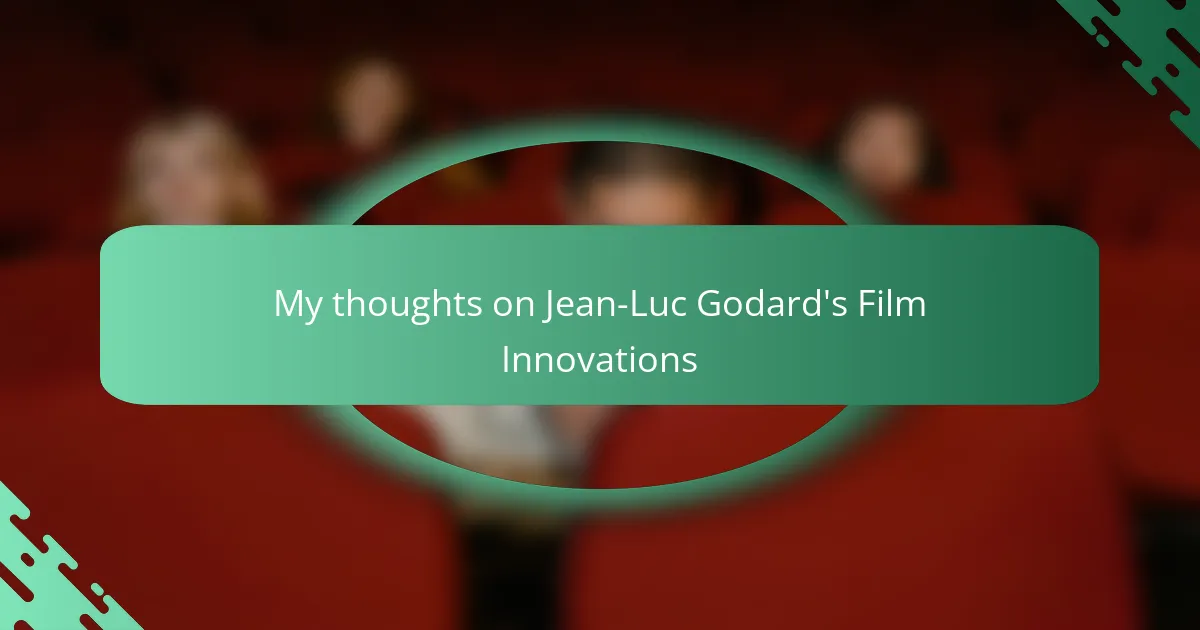Key takeaways
- Jean-Luc Godard revolutionized filmmaking with techniques like jump cuts and self-reflexivity, challenging traditional narrative structures.
- His films often blend politics and art, encouraging audiences to reflect on social commentary within cinema.
- Godard’s influence is evident in modern filmmakers, inspiring creative freedom and experimentation in storytelling.
- Emphasizing emotional engagement, Godard’s work invites viewers to actively participate and question narrative strategies.
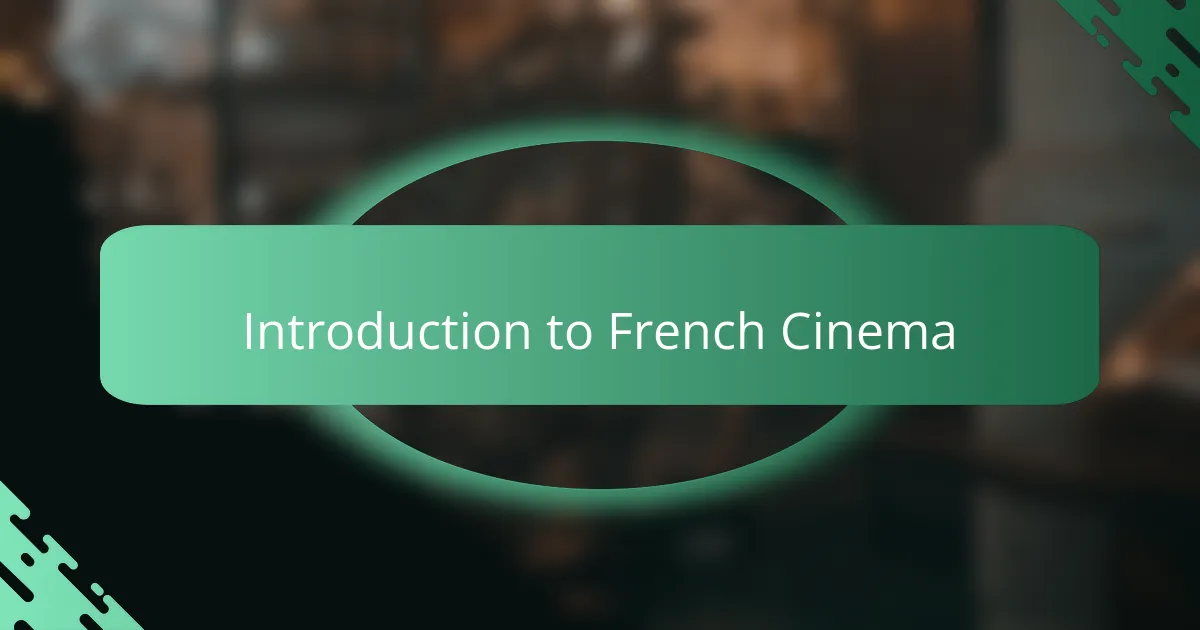
Introduction to French Cinema
French cinema has always been a wellspring of creativity and innovation. From its early days with pioneers like the Lumière brothers to the revolutionary works of directors like Jean-Luc Godard, French film has continuously pushed the boundaries of storytelling and filmmaking techniques. I remember the first time I watched a French film—there was something uniquely captivating about the way it conveyed emotions and narratives, making me crave more.
Godard’s film innovations, particularly his approach to editing and narrative structure, challenged traditional filmmaking norms. His works often break the fourth wall and play with the concept of time, engaging viewers in a profound way. I find that this level of innovation makes watching French films not just an entertainment experience but an intellectual one as well.
| Traditional Cinema | French New Wave (Godard) |
|---|---|
| Linear storytelling | Non-linear narratives |
| Standard editing techniques | Jump cuts and innovative editing |
| Cinematic realism | Playfulness and surrealism |
| Focus on plot | Focus on character and themes |
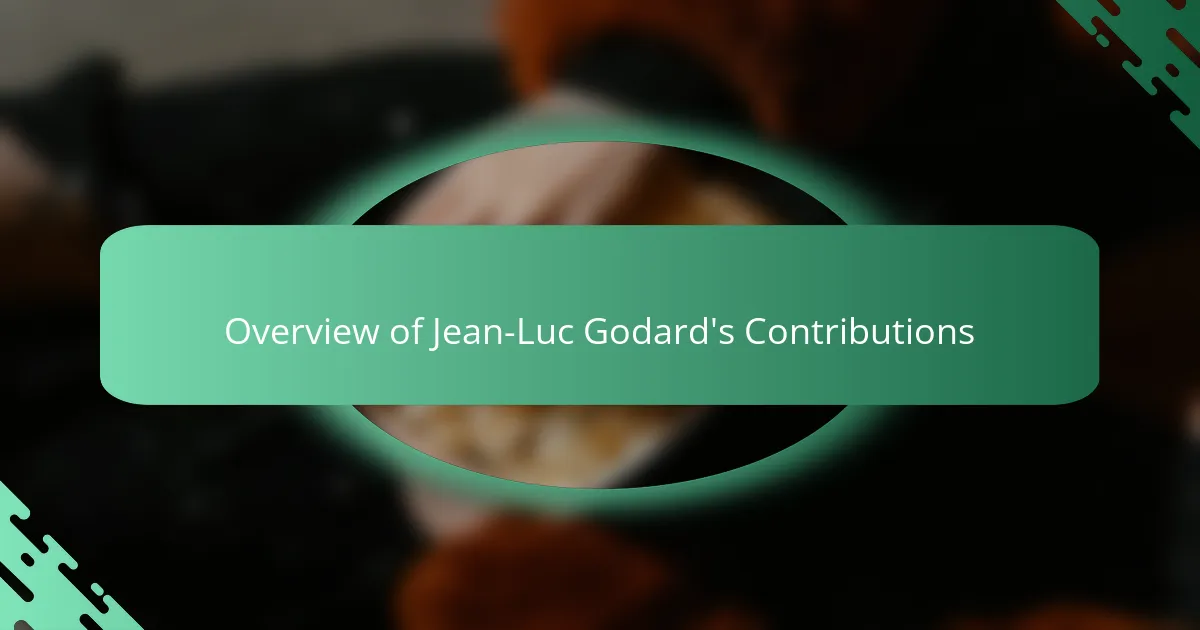
Overview of Jean-Luc Godard’s Contributions
Jean-Luc Godard’s contributions to cinema are nothing short of revolutionary. His artistic vision transformed filmmaking in ways that are still felt today, breaking traditional narrative structures and experimenting with visual styles. I remember the first time I watched “Breathless”—I was captivated by its raw energy and unconventional storytelling. It felt like I was witnessing the birth of a new language in film, one that spoke to the complexities of the human experience.
Godard’s work has left a lasting impact that extends beyond the French New Wave. His innovative techniques invited audiences to question the medium itself. I often find myself reflecting on how he challenged the status quo and encouraged filmmakers to embrace bold creativity. Here are some key contributions that define his legacy:
- Pioneered jump cuts, creating a dynamic and disjointed narrative style.
- Introduced direct address, breaking the fourth wall to engage viewers.
- Explored themes of identity, politics, and existentialism in unique ways.
- Blurred the lines between genres, merging documentary and fiction seamlessly.
- Emphasized the importance of sound and music, using them as active storytelling elements.
These elements not only revolutionized French cinema but also influenced filmmakers around the world. Godard’s fearlessness continues to inspire those who wish to push boundaries in their own work.
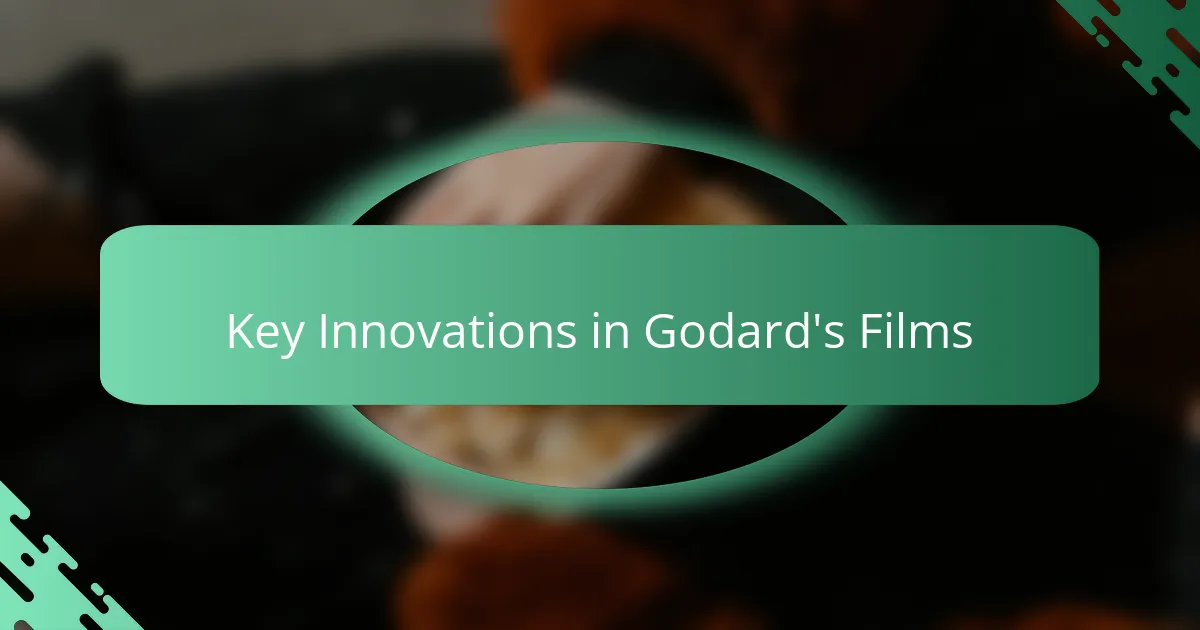
Key Innovations in Godard’s Films
When I think about Jean-Luc Godard’s contributions to cinema, several key innovations come to mind that truly transformed the film landscape. His use of jump cuts, for example, disrupted the conventional narrative flow, compelling audiences to engage actively with the story instead of passively consuming it. I remember watching “Breathless” for the first time and feeling that exhilarating jolt as scenes abruptly shifted. It challenged my perception of rhythm in film.
Additionally, Godard’s incorporation of political themes and self-reflexivity offers a profound commentary on society and filmmaking itself, which I find incredibly impactful. In “Weekend,” for instance, he cleverly blends narrative and documentary styles, creating a jarring yet thought-provoking experience. It urges viewers to reflect on the context of the film industry and its role in shaping societal views.
Key Innovations:
– Jump Cuts: This technique shattered traditional continuity, inviting viewers to question narrative strategies.
– Self-Reflexivity: Godard’s films often acknowledge their own storytelling methods, prompting audiences to consider the nature of cinema.
– Political Commentary: His works frequently incorporate critiques of society, making films relevant beyond mere entertainment.
– Mixing Genres: He blurs the lines between documentary and fiction, enriching the viewing experience with layered meanings.
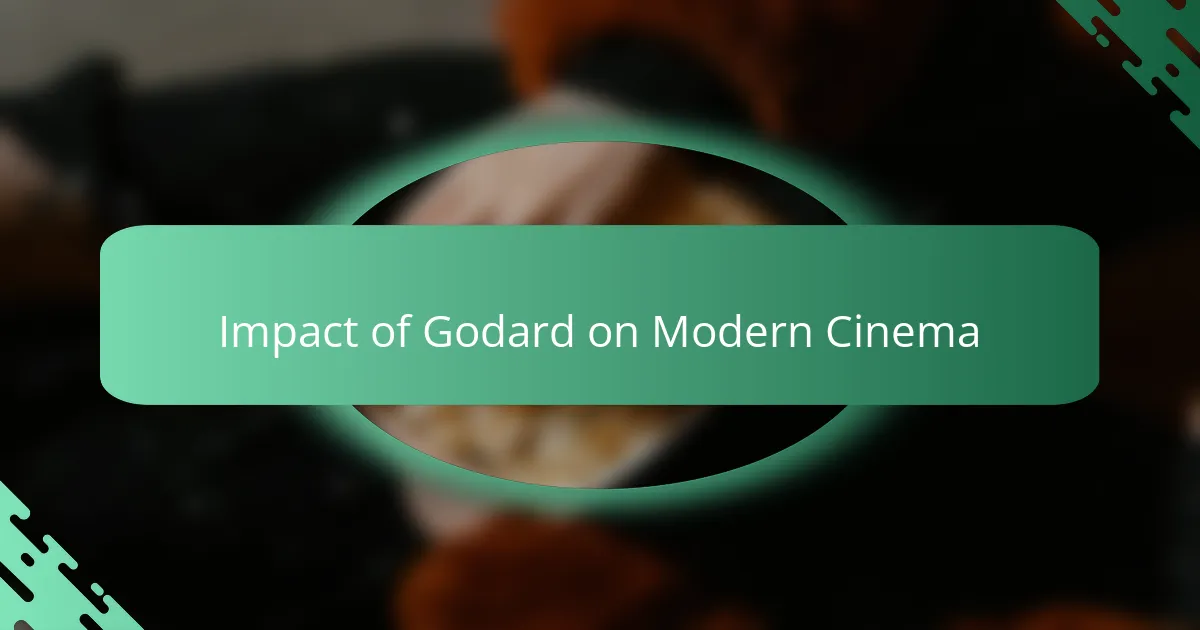
Impact of Godard on Modern Cinema
Jean-Luc Godard’s impact on modern cinema is profound and widely acknowledged. His innovative techniques, such as jump cuts and breaking the fourth wall, have inspired countless filmmakers to push the boundaries of traditional storytelling. For me, watching “Breathless” for the first time was a revelation. It ignited a passion for cinema that was raw and unfiltered, showcasing how films could reflect real life rather than just escape from it.
Godard’s fearless approach encouraged a new wave of experimentation that resonates in many contemporary films. I find it exciting to see his influence in directors like Quentin Tarantino and Greta Gerwig, who aren’t afraid to mix genres and play with structure. It’s as if Godard handed us a toolkit inviting us to explore our own creative boundaries.
Here’s a comparison table showcasing some of his contributions:
| Godard’s Innovations | Modern Cinema Examples |
|---|---|
| Jump Cuts | “Pulp Fiction” by Quentin Tarantino |
| Breaking the Fourth Wall | “Lady Bird” by Greta Gerwig |
| Non-linear Storytelling | “Eternal Sunshine of the Spotless Mind” by Michel Gondry |
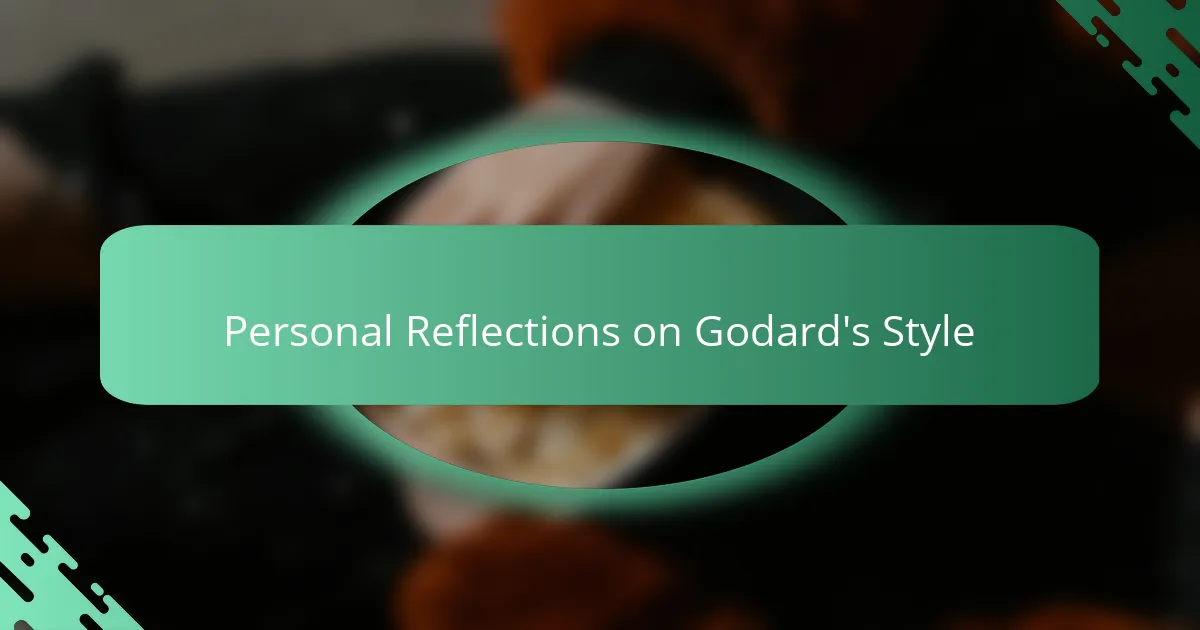
Personal Reflections on Godard’s Style
Jean-Luc Godard’s style is undeniably unique, and it often leaves audiences both captivated and challenged. I remember watching “À bout de souffle” for the first time and feeling a rush of excitement as traditional storytelling boundaries were upended. His innovative use of jump cuts and unconventional pacing forced me to pay closer attention, almost as if I was participating in the film’s narrative rather than just passively watching.
Moreover, Godard’s approach to blending art and politics struck a chord with me. It made me reflect on how films can serve as a powerful medium for social commentary. His ability to weave political themes into everyday life showcases the potential of cinema to provoke thought and inspire action.
- Use of jump cuts to disrupt narrative flow
- Playful engagement with the audience through direct addresses
- Intertextual references that nod to other filmmakers or cultural texts
- Non-linear storytelling that invites interpretation
- Blending genres, often mixing comedy with drama or documentary elements
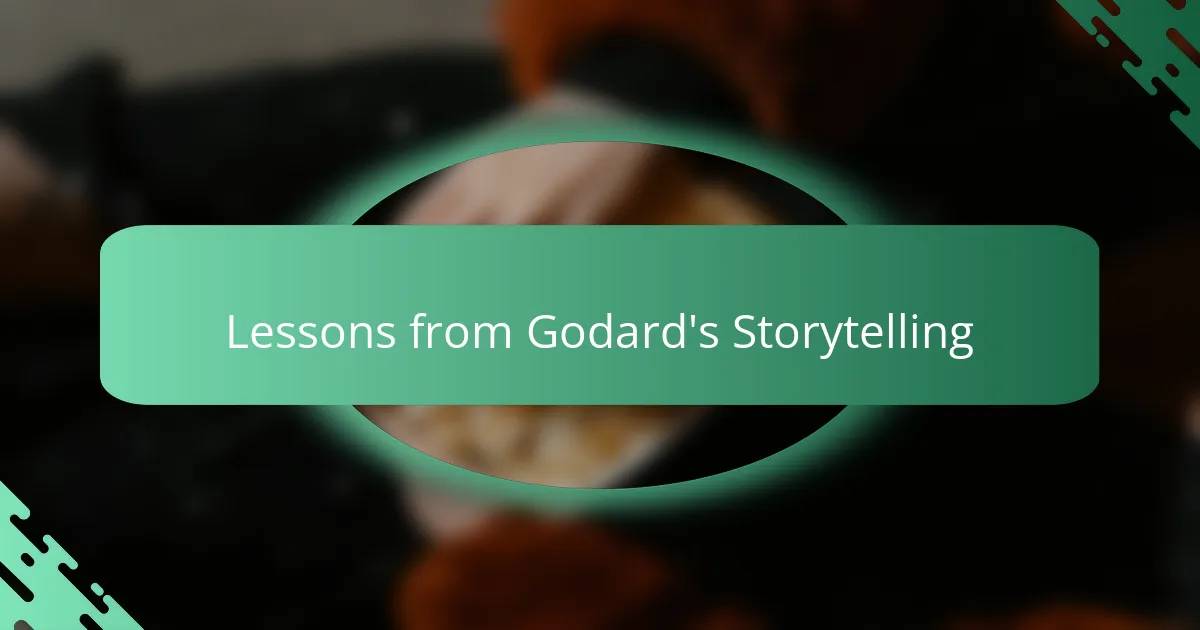
Lessons from Godard’s Storytelling
I’ve found that Godard’s storytelling offers invaluable lessons about the power of disruption. His use of jump cuts not only surprises the audience but also elevates engagement. I remember the first time a scene abruptly shifted; it jolted me awake, making me acutely aware of the film as an art form rather than mere entertainment. It’s a fascinating reminder that shaking up expectations can lead to deeper emotional connections with the material.
Another essential lesson from Godard is the significance of self-reflexivity in storytelling. By breaking the fourth wall, he invites viewers to be active participants rather than passive observers. I often catch myself rethinking scenes after they end, realizing how his direct addresses encouraged me to engage with the narrative on different levels. This technique reminds me that films can challenge audiences to reflect critically on what they’re watching.
Finally, Godard’s blending of genres compels us to consider how stories can transcend traditional boundaries. I recall feeling intrigued by how seamlessly he merges documentary and fiction, leaving me questioning the nature of truth in cinema. The emotional and thematic depth that results from this mixing inspires me to seek new ways to tell my own stories, merging styles and forms to create something distinct and resonant.
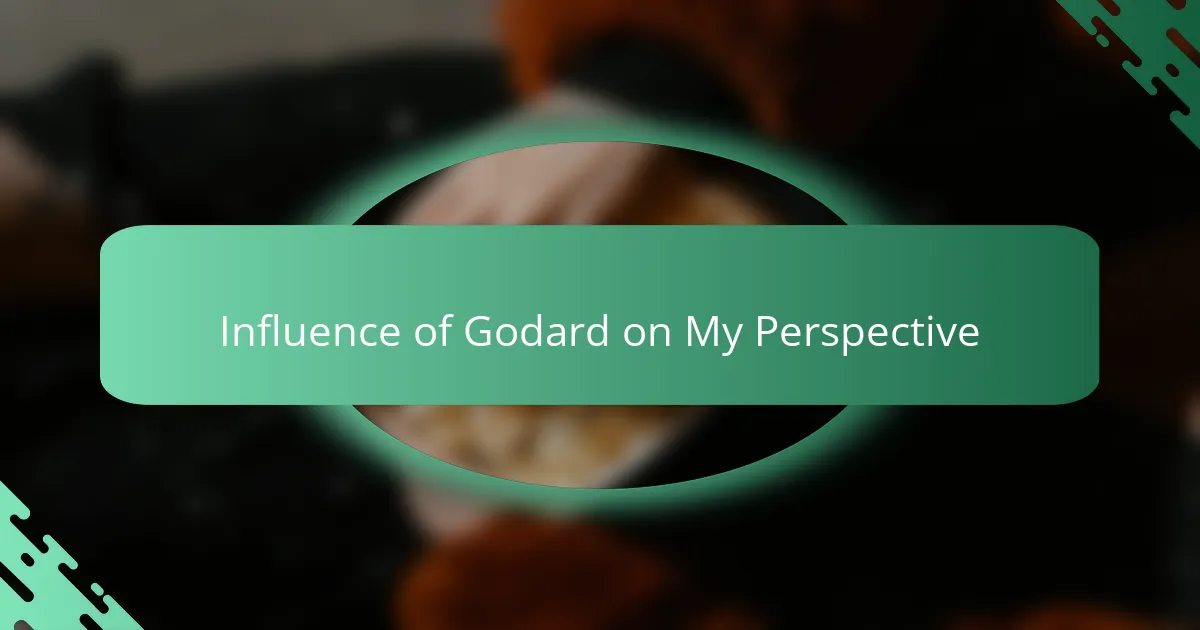
Influence of Godard on My Perspective
Jean-Luc Godard’s films have significantly shaped my perspective on cinema and storytelling. His innovative approach to narrative structure and editing challenged the conventional norms I had grown up with. I vividly remember the first time I watched “Breathless.” The way Godard broke the fourth wall and rushed through scenes felt like a breath of fresh air, opening my eyes to the endless possibilities within filmmaking.
Reflecting on Godard’s influence, I’ve come to appreciate the art of spontaneity in my own creative work. His ability to weave philosophical ideas into everyday life resonated with me deeply, urging me to consider how cinema can provoke thought as well as entertain. I find that embracing an unconventional style leads to richer storytelling, allowing me to connect with my own audience on a more personal level.
- Godard’s unique narrative techniques have encouraged me to experiment with my own storytelling style.
- His emphasis on breaking cinematic norms has taught me the importance of creative freedom in filmmaking.
- Encountering his work has expanded my understanding of film as a medium for philosophical exploration, making me more contemplative in my own projects.
